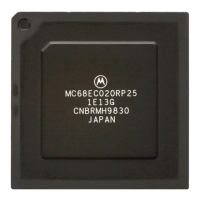MOTOROLA M68020 USER’S MANUAL 1- 9
Table 1-1. Addressing Modes
Addressing Modes Syntax
Register Direct
Data
Address
Dn
An
Register Indirect
Address
Address with Postincrement
Address with Predecrement
Address with Displacement
(An)
(An)+
–(An)
(d
16
, An)
Address Register Indirect with Index
8-Bit Displacement
Base Displacement
(d
8
, An, Xn)
(bd, An, Xn)
Memory Indirect
Postindexed
Preindexed
([bd, An], Xn, od)
([bd, An, Xn], od)
PC Indirect with Displacement (d
16
, PC)
PC Indirect with Index
8-Bit Displacement
Base Displacement
(d
8
, PC, Xn)
(bd, PC, Xn)
PC Indirect
Postindexed
Preindexed
([bd, PC], Xn, od)
([bd, PC, Xn], od)
Absolute Data Addressing
Short
Long
(xxx).W
(xxx).L
Immediate #<data>
NOTE:
Dn = Data Register, D7–D0
An = Address Register, A7–A0
d
8
, d
16
= A twos complement or sign-extended displacement added as part
of the effective address calculation; size is 8 (d
8
) or 16 (d
16
) bits;
when omitted, assemblers use a value of zero.
Xn = Address or data register used as an index register; form is
Xn.SIZE
*
SCALE, where SIZE is .W or .L (indicates index register
size) and SCALE is 1, 2, 4, or 8 (index register is multiplied by
SCALE); use of SIZE and/or SCALE is optional.
bd = A twos-complement base displacement; when present, size can be
16 or 32 bits.
od = Outer displacement added as part of effective address calculation
after any memory indirection; use is optional with a size of 16 or 32
bits.
PC = Program Counter
<data> = Immediate value of 8, 16, or 32 bits
( ) = Effective Address
[ ] = Use as indirect access to long-word address.

